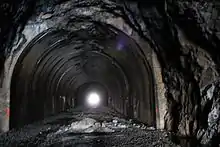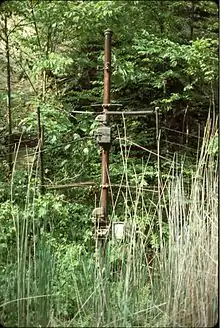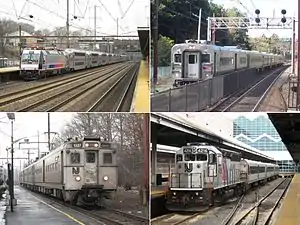Roseville Tunnel
Roseville Tunnel is a 1,024-foot (312 m)[1] two-track railroad tunnel on the Lackawanna Cut-Off in Byram Township, Sussex County, New Jersey. The tunnel is on a straight section of railroad between mileposts 51.6 and 51.8 (83 km), about 6 miles (9.7 km) west of Port Morris Junction. Operated from 1911 to 1979, it is undergoing work intended to return it to service no earlier in 2026.


The tunnel was built between 1908 and 1911 by the Delaware, Lackawanna & Western Railroad (DL&W) as part of the Lackawanna Cut-Off, an immense, spare-no-expense project intended to create the straightest, flattest route practicable for its main line through the mountains of northwestern New Jersey. The contractor was David W. Flickwir of Roanoke, Virginia.[2] Originally, the DL&W had planned to have a cut, not a tunnel, at this location. At 140 feet (43 m) deep, it would have been the deepest on the Cut-Off. But in October 1909, anticlinal rock was encountered, described as "bastard granite",[2] which contractors said was "so brittle and soft that you could scoop it up by the handful. It was white in color and looked much like Roquefort cheese." The fear was that this decayed rock could not be relied upon to provide sufficiently rigid support for a cut.[3] As a result, Assistant Chief Engineer Wheaton recommended to President Truesdale that a tunnel be drilled instead, and Truesdale concurred, with work to bore a tunnel starting in December 1909.[4] Ultimately, some 35,000 cubic yards of material were removed to create the bore.[1]
Roseville Tunnel opened on December 24, 1911, and permitted a 70 mph (113 km/hr) speed limit. In 1958, the DL&W single-tracked the line in anticipation of a merger with the Erie Railroad. Its successor, the Erie Lackawanna Railway (EL), shifted the remaining track in the tunnel several feet north to boost clearance for high-and-wide railroad cars. Conrail assumed operations of the EL in 1976, but ended service on the Cut-Off in January 1979. A protracted effort to prevent the rail from being removed, Conrail pulled up the tracks during the summer of 1984 and subsequently sold the right-of-way to two land developers.
The State of New Jersey acquired the right-of-way in 2001; ten years later, NJ Transit began to rebuild the line as part of the Lackawanna Cut-Off Restoration Project.
Rockslides

New Jersey geology makes rockslides, which can derail trains, a constant threat in deep cuts. After the Cut-Off was closed for a month by a 1941 slide in Armstrong Cut just west of Johnsonburg, DL&W brought in heavy equipment to lessen the slope on the cut's northern side, making it nearly impossible for another rockslide to occur there.
But Roseville proved to be a different matter. Unless the Lackawanna was willing to close the line for a prolonged period, there was no way to safely scale back the tall, steep rockwalls through Colby Cut, the tunnel's western approach. Instead, after the Armstrong Cut Slide, the DL&W paid a shantyman to watch for fallen rocks at Roseville. A hand-thrown switch had already been installed in 1913 to allow trains to shift tracks if one were blocked by fallen rocks, indicating that the railroad was acutely aware of the potential threat from almost the very beginning.[5] In later years (probably around 1950), electronic detectors were installed that could automatically set trackside signals to red if rocks broke through the detector fencing. In the 1970s, a concrete lining was applied to the westernmost 133 feet (41 m)[6] of the tunnel to prevent rockfalls inside. This work did not prevent chunks of rock from dislodging later on, after the abandonment of the Cut-Off.
Rehabilitation for Andover service
In 2011, New Jersey Transit received approval to re-lay 7.3 miles (11.8 km) of track from Port Morris Junction through the tunnel in order to open commuter rail service westward to Andover, New Jersey.
The tunnel work, as stated in the invitation to bidders, will include: "removal of loose rock, rock bolting to secure unstable rock blocks, repair of the existing concrete tunnel liner, installation of a membrane liner that will provide a continuous tunnel waterproofing system, installation of CCTV (closed-circuit television) cameras at both portals, and installation of a lighted pedestrian path inside the tunnel that extends a minimum of 50 feet (15 m) beyond both portals. A radio system must also be installed that provides radio signal and coverage inside the tunnel. The requirements will also include rock excavation from the west tunnel portal, effectively reducing the overall tunnel length by a minimum of 15 feet (4.6 m). The work also includes railroad track bed excavation, initial ballast placement, and rock excavation and slope protection and stabilization of loose and potentially loose rock on both the west and east rock cut approaches to the tunnel. This slope protection shall address rockfall hazard protection including construction of adequate catchment areas, the installation of cable mesh and/or netting, vegetation and tree removal, removal of loose rock and rock bolting to secure unstable blocks. The protection shall extend approximately 1,700 feet (520 m) from the west portal and 200 feet (61 m) from the east portal. The work also includes a section of track roadbed restoration beyond the west portal, including cutting, clearing, and disposal of all brush, trees, and vegetative matter, and its drainage system, approximately 8,000 feet (2460 m) long."[7]
This work is to be completed within 730 days (two years) starting in 2021. In all, the Roseville Tunnel part of the reactivation project will cost $24 million. The re-opening of the line to Andover is projected to occur no earlier than 2026.[7]
Notes
- Taber & Taber 1980, p. 35
- Dana, Richard Turner; William Lawrence Saunders; Construction Service Company (1911). Rock drilling: with particular reference to open cut excavation and submarine rock removal. J. Wiley & Sons. pp. 99–106. Retrieved November 15, 2012.
roseville tunnel.
CS1 maint: multiple names: authors list (link) - The Lackawanna Railroad in Northwestern New Jersey by Larry Lowenthal and William T. Greenberg, Jr., p. 75, Tri-State Railway Historical Society, Inc., 1987.
- DL&W President Truesdale's correspondence file from October–December 1909, Steamtown National Historic Site archives, Scranton, Pennsylvania.
- "What Signal Departments Are Doing: A Summary of Some of the Big Work of the Last Few Months and Some Plans for the Future". Railway Signaling and Communications, Volume 7. Simmons-Boardman. January 1914. p. 19. Retrieved November 15, 2012.
- http://www.njtransit.com/pdf/LackawannaEAJune2008.pdf
- "Request for Special Pre-Qualification DESIGN and CONSTRUCTION OF THE ROSEVILLE TUNNEL REHABILITATION In Byram Township, Sussex County, New Jersey". Invitation For Bid No. 16-008X. NJ Transit. p. 4. Retrieved October 27, 2016.
References
- Taber, Thomas Townsend; Taber, Thomas Townsend III (1980). The Delaware, Lackawanna & Western Railroad in the Twentieth Century. 1. Muncy, PA: Privately printed. ISBN 0-9603398-2-5.CS1 maint: ref=harv (link)
- The Lackawanna Railroad in Northwestern New Jersey by Larry Lowenthal and William T. Greenberg, Jr., Tri-State Railway Historical Society, Inc., 1987.
- Farewell to the Lackawanna Cut-Off (Parts I-IV), by Don Dorflinger, published in the Block Line, Tri-State Railway Historical Society, Inc., 1984-1985.
